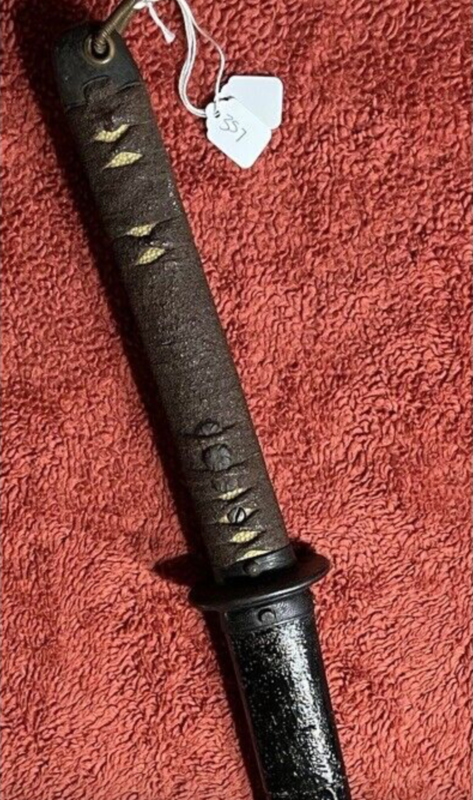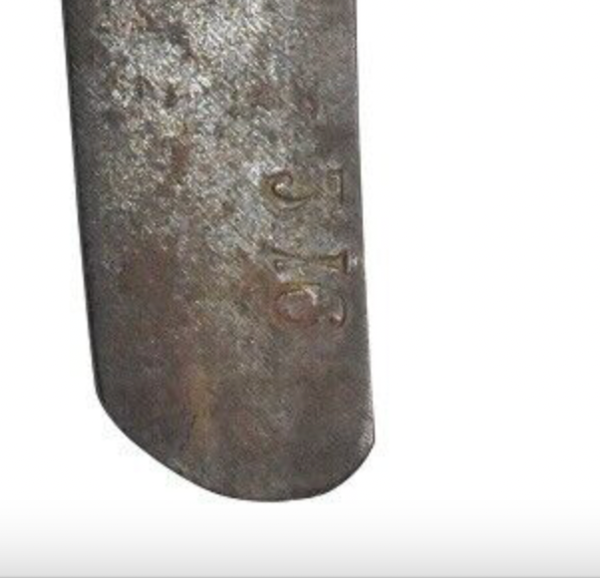
John C
Gold Tier-
Posts
1,932 -
Joined
-
Last visited
-
Days Won
15
Content Type
Profiles
Forums
Events
Store
Downloads
Gallery
Everything posted by John C
-
Small Wakizashi information request
John C replied to Davont's topic in General Nihonto Related Discussion
David: Welcome! Just a guess, however there were a lot of wakizashis made in the shinto and shin shinto eras because merchants and other officials and business types were allowed to carry them. It is possible, therefore, that it could have been made for someone slight of stature. Another possibility, and more likely in my opinion, is that it is a "boys day" sword. These were made specifically for a boys birthday or coming of age and tend to be smaller than average waks. John C. -
Thanks @Bruce Pennington! I had assumed the S shape was a stylized pond like in the pic below. But flowers floating on a river or stream make more sense. John C.
-
I think in this case the handle needs to be unscrewed from the back, so he probably doesn't want to damage the handle and is reluctant. John C.
-
Let me guess...he said "scroll down" for more pics! John C.
-
Noah: I think the one blade with the blue background is from Hennadiy2006, correct? The blue background is kind of his trademark, just like Komonjo's wood floor. He has one for sale for 650 at the moment. I know he takes a long time to sell things because he is generally very overpriced. Not saying he is a bad seller or that the sword isn't legit, just think you could find something cheaper. John C.
-
Noah: A couple of observations: The clasp hooked to the hanger looks legit. It would go on the end of a leather strap hooked to the hanger ring. The serial number on the blade, however, gives me pause. There does not seem to be an arsenal mark after the numbers. Not unheard of, but very rare. And indeed, 67977 can be made with just two stamps. Nothing conclusive without better pictures. I too believe the low feedback number, the unwillingness to provide better pictures, and initial bad pictures send up some red flags. John C.
-
Robyn: A lot of the tsuba enthusiasts are on the Tosogu forum under the Nihonto Discussion category. You might want to post this information over there. John C.
-
@Brian Brian: Is there a memorial forum where one could leave condolences, stories, anecdotes, etc. for members? Would that be something you could entertain? John C.
-
Notice the line of damage along the entire edge of the saya? I have noticed this on at least 3 or 4 souvenir swords. Seems to be another tell-tale sign. John C.
-
William: Sometimes it helps to know which questions to ask. Here are some questions you could answer about the sword that will help you with your decision (all of the answers can be found on this forum and the already referenced web sites). 1. What are the red marks on the tang and what do they mean? 2. What type of tsuba is that? (does it go with that style of sword?) 3. The latch release button does NOT appear to be in the middle of the fuchi. What type of sword does that signify? 4. Does the color and style of the tassel and cord mean anything? 5. How many hangers are on the saya? What type of sword does that signify? 6. Are there any stamps on the nakago? If so, what do they mean? 7. Lastly, put all of those answers together. Do they make sense together as whole given what you think the sword should be? Just know, I'm not being critical. I hope researching these answers will help you not only in your research skills, but also in your identification skills. John C.
-
John: And on a related question, are the different colors of the tassels meaningful or is that from age? (Sorry for jumping in, Bruce. Still trying to learn all of this stuff). John C.
-
Ben: Choji oil is traditional. It is 90 to 99 percent mineral oil mixed with clove oil. I would shy away from oils designed to "open" pores of the metal. John C.
-
Attention Mantetsu Owners: A Survey
John C replied to Bruce Pennington's topic in Military Swords of Japan
Trystan: Very interesting. Around 1.5 million blades confiscated (including bayonets)! And out of that number, relatively few gunto at just over 50K. So we know how many gunto were made and how many were confiscated. I suspect, we could figure out how many were distributed by knowing the number of individuals qualified to carry one. With a few more documents, we may be able to actually figure out how many were lost during the war. John C. -
Update: Just heard back from the seller. He/she indicate there is no star stamp on the blade. This could be a Frankenblade or maybe the seller is mistaken. John C.
-
Leon: I don't have the experience to speak about the blade and serial numbers, however the marks on the fuchi are correct. According to Bruce's stamp document, the stamps reference the Suya Shoten Co., Ltd Kokura Arsenal, Tokyo 1st Arsenal. In addition, the tsuba, top latch, and seppa looks correct. The "throat" in the scabbard also looks correct. John C.
-
Being cast and possibly used as an offering, the sword my never have been intended for traditional use. Therefore, the material used was less important than the intended religious significance. Just a thought. John C.
-
Attention Mantetsu Owners: A Survey
John C replied to Bruce Pennington's topic in Military Swords of Japan
Thomas: Thank you. I am trying to get a sense of how many complete swords were used during the war. But ultimately, we will never know how many survived the battlefield and the subsequent destruction by occupying forces. In addition, these numbers do not include the various private/family blades that made it into service. John C. -
Funny. I've seen the newer kanji on fake swords. I wondered what it meant. John C.
-
Attention Mantetsu Owners: A Survey
John C replied to Bruce Pennington's topic in Military Swords of Japan
In an effort to learn, I have two questions: 1. Do the referenced numbers on the chart refer to planned production or actual delivered production? 2. What happened to the bare blades in the second row? (not including the ones sent to Tokyo from the other arsenals). John C. -
Steve: Thank you for the link. Now I can see how that character may have been formed that way. John C.
-
Jussi: I second Jesse's sentiment. Great reply on the inner workings of NBTHK! And thank you for the research. I appreciate it. John C.
-
Rivkin: Thank you for that concise analysis. I suspect, then, the process of gimei is similar to that of bad check writers, who often stop to look up at the signature in order to get it right! You are probably correct about the distortion the light causes on the characters. I hadn't considered that. I couldn't reconcile how the smith could get a character so wrong by misplacing a stroke (the vertical stroke on the "wara" character appears to start on the right rather than on the left). Thank you again, John C.
-
Interesting. I didn't notice the double release buttons. John C.
-
A late model black saya? Note the handle, fuchi, etc. are also black. https://www.ebay.com/itm/134133558279?hash=item1f3afbac07%3Ag%3Au3gAAOSwiE9jETzo&amdata=enc%3AAQAHAAAAoPTuyp%2FzLQOEgmqC8SvcYcvKWGwlVN%2Ftw5S%2FyrHfnpZu8K6Ht9A6XcpjzlypzYLxjCvwKbsEzGj3a5eZIwjofbn6hKDAcCx%2B%2Bsue6bAGaH8SQIcxoBqyH8p6dWmS4PVxgAZ5qIa2YbzgTPr2yShEznv%2BaVsRAaKi85puDYDxITrwgNxylyYX3Lrgfrgqm9JOLLLOkBubHwtULszMQ2rpQwU%3D|tkp%3ABk9SR4bxsJShYQ&LH_ItemCondition=4|10 John C.
-
Bruce: Another interesting numbered nakago. Looks like a kai gunto (souvenir mounts?) with 516 stamped at the bottom. But it looks as if the numbers were made using a mei chisel rather than a number stamp. More pics here: https://www.ebay.com/itm/225292417867?hash=item3474797b4b%3Ag%3AL1sAAOSwcpNjlUTM&amdata=enc%3AAQAHAAAAoBbnJvOl26RRfqmo7F0XB6IUU7M%2BcldZ%2FzWTyxei0lTZEn0PaxiD9ZUiOp74qUa1Iwe6oaz2YUEqcK0zU5Nc4aWLncK3JGVuUtSo55%2BKsGrLJzXZG%2Bm91LNAh5ubRtr0sZnBo%2F%2FlqK8je%2B2sh%2Fjxz1CvaMmh%2Fsx8bH7HEhyoAV2xiGGRt75PPqXcEaeM7QivfvIK1KD6cyxv8Vzu7rKTlxA%3D|tkp%3ABk9SR4yn9JGhYQ&LH_ItemCondition=4|10 John C.





